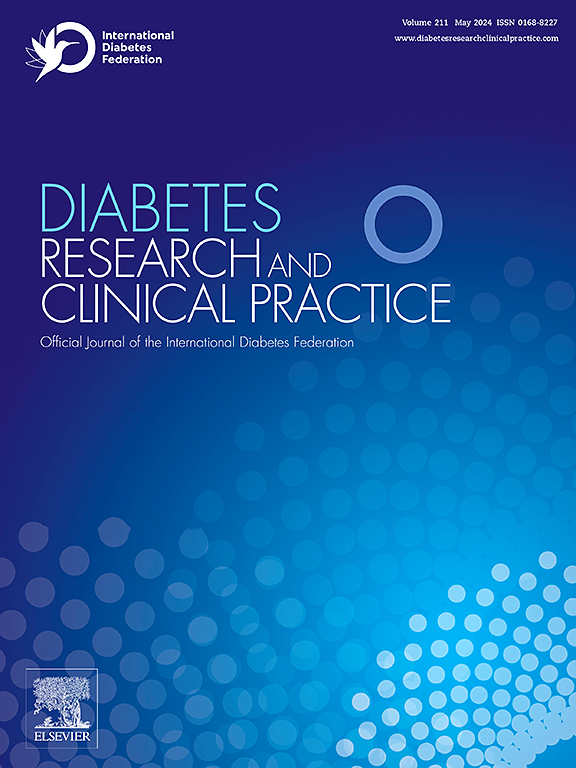Glycated haemoglobin is a major predictor of disease severity in patients with NAFLD
IF 6.1
3区 医学
Q1 ENDOCRINOLOGY & METABOLISM
引用次数: 0
Abstract
Objectives
Currently, non-invasive scoring systems to stage the severity of non-alcoholic fatty liver disease (NAFLD) do not consider markers of glucose control (glycated haemoglobin, HbA1c); this study aimed to define the relationship between HbA1c and NAFLD severity in patients with and without type 2 diabetes.
Research design and methods
Data were obtained from 857 patients with liver biopsy staged NAFLD. Generalized-linear models and binomial regression analysis were used to define the relationships between histological NAFLD severity, age, HbA1c, and BMI. Paired biopsies from interventional studies (n = 421) were used to assess the impact of change in weight, HbA1c and active vs. placebo treatment on improvements in steatosis, non-alcoholic steatohepatitis (NASH), and fibrosis.
Results
In the discovery cohort (n = 687), risk of severe steatosis, NASH and advanced fibrosis correlated positively with HbA1c, after adjustment for obesity and age. These data were endorsed in a separate validation cohort (n = 170). Predictive modelling using HbA1c and age was non-inferior to the established non-invasive biomarker, Fib-4, and allowed the generation of HbA1c, age, and BMI adjusted risk charts to predict NAFLD severity. Following intervention, reduction in HbA1c was associated with improvements in steatosis and NASH after adjustment for weight change and treatment, whilst fibrosis change was only associated with weight change and treatment.
Conclusions
HbA1c is highly informative in predicting NAFLD severity and contributes more than BMI. Assessments of HbA1c must be a fundamental part of the holistic assessment of patients with NAFLD and, alongside age, can be used to identify patients with highest risk of advanced disease.
糖化血红蛋白是预测非酒精性脂肪肝患者病情严重程度的主要指标。
目的:目前,对非酒精性脂肪肝(NAFLD)严重程度进行分期的非侵入性评分系统并未考虑血糖控制指标(糖化血红蛋白,HbA1c);本研究旨在确定有无2型糖尿病患者中HbA1c与非酒精性脂肪肝严重程度之间的关系:数据来自857名经肝活检分期的非酒精性脂肪肝患者。采用广义线性模型和二项回归分析来确定组织学非酒精性脂肪肝严重程度、年龄、HbA1c和体重指数之间的关系。来自干预研究的配对活检样本(n = 421)被用来评估体重、HbA1c 和活性治疗与安慰剂治疗的变化对脂肪变性、非酒精性脂肪性肝炎(NASH)和纤维化改善的影响:在发现队列(n = 687)中,经肥胖和年龄调整后,严重脂肪变性、非酒精性脂肪性肝炎和晚期纤维化的风险与 HbA1c 呈正相关。这些数据在另一个验证队列(n = 170)中得到了认可。使用 HbA1c 和年龄进行预测建模的效果并不亚于已确定的非侵入性生物标志物 Fib-4,并可生成 HbA1c、年龄和体重指数调整风险图表,以预测非酒精性脂肪肝的严重程度。干预后,在调整体重变化和治疗后,HbA1c的降低与脂肪变性和NASH的改善有关,而纤维化的变化仅与体重变化和治疗有关:结论:HbA1c 在预测非酒精性脂肪肝严重程度方面具有很高的参考价值,其贡献超过体重指数。HbA1c评估必须成为对非酒精性脂肪肝患者进行整体评估的一个基本组成部分,并可与年龄一起用于识别罹患晚期疾病风险最高的患者。
本文章由计算机程序翻译,如有差异,请以英文原文为准。
求助全文
约1分钟内获得全文
求助全文
来源期刊

Diabetes research and clinical practice
医学-内分泌学与代谢
CiteScore
10.30
自引率
3.90%
发文量
862
审稿时长
32 days
期刊介绍:
Diabetes Research and Clinical Practice is an international journal for health-care providers and clinically oriented researchers that publishes high-quality original research articles and expert reviews in diabetes and related areas. The role of the journal is to provide a venue for dissemination of knowledge and discussion of topics related to diabetes clinical research and patient care. Topics of focus include translational science, genetics, immunology, nutrition, psychosocial research, epidemiology, prevention, socio-economic research, complications, new treatments, technologies and therapy.
 求助内容:
求助内容: 应助结果提醒方式:
应助结果提醒方式:


